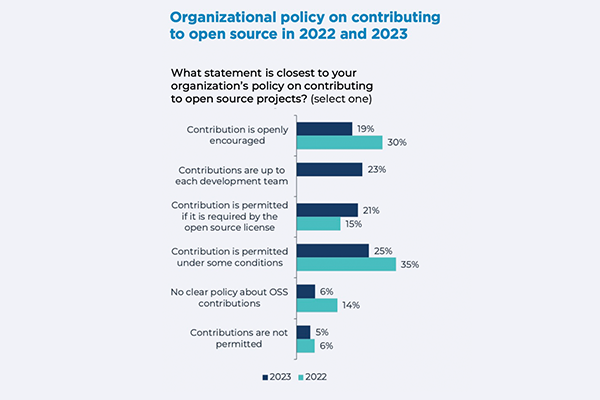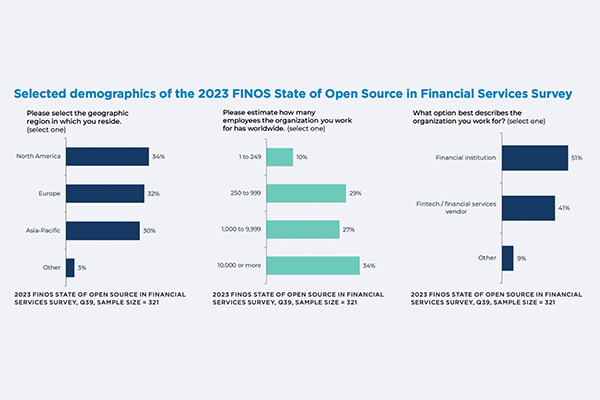As I was reading this year’s State of Open Source in Finance report, it took me back to my early career working in Financial Services. It was a fair while ago, so I won’t pretend to remember all of the codes and regulations inside out, but I do remember a world of secrets and confidentiality, where information and “intellectual property” had to be kept tightly restricted. For me, it’s no surprise that Financial Services organisations struggle to be as involved in Open Source projects and technologies as they might like.
Consumption before contribution
While it’s great to see the number of organisations with policies allowing consumption on the rise, the number with policies allowing contribution is lagging behind.

When you break the data out by organisation size, I got more of an idea of why: smaller organisations are more likely to have OSPOs (Open Source Program Offices) than larger ones, and they also reported having more communications around Open Source in their organisation. That is, Open Source is an actively recognised concern across the organisation.

I can empathise with the concerns that leaders of large organisations may have around getting involved in Open Source projects. If you spend most of your waking hours worrying about keeping things locked down, why would you open yourself up to something that sounds like the polar opposite? Let’s look at the common concerns leaders have with Open Source:
- It’s less secure than proprietary software from big vendors. Open Source code is intrinsically more secure, as it can be tested by an unlimited number of people, not just the owners of closed source code.
- It’s not compliant. Yes, it’s not as straightforward as buying proprietary software with a pre-approved licence; however, organisations like FINOS are introducing more and more tools and standards to address this.
- It’s not supported. While Open Source software may not come with a 24/7 support line like the big vendors, how useful are those helpdesks anyway!? The Open Source community will be far more motivated to help you fix any issue, or your developers – who are likely very familiar with the issue – can address it themselves.
- Our competitors will steal our secrets. True, if you use Open Source for everything. In reality, most financial services organisations use the same proprietary software for their internal operations, so you’re not revealing anything by switching that software for an Open Source equivalent.
It’s one thing to use Open Source software, but why go one step further and contribute to it? Technologists will provide many reasons. For me, it all comes down to the culture of an organisation.
The impact of culture in large organisations
It’s natural as companies grow for there to be less transparency and engagement: the thought of sharing your company’s inner workings with five thousand staff is much less appealing than when you have five hundred, all of whom you probably know by name.
I love the open and collaborative culture that I’ve experienced working in tech companies, but I’ve even seen it take a hit there, when they become publicly listed and suddenly have regulations and shareholders to worry about. It’s easy for a culture of fear and secrecy to quickly take over, where information is on a need-to-know basis and knowledge is power. At that point, many employees disengage, and your organisation becomes nothing more than an income source to them, rather than a cause they believe in and will work hard for.
So how do you keep employees engaged when you feel you can no longer tell them everything that’s happening?
Rather than an unnecessary risk, Open Source community engagement could actually be an answer.
The technology talent market is on a constant merry go round between a fight for talent and lots of people on the market after the latest round of layoffs. Having a positive Open Source policy is a great way to attract enthusiastic technologists to your organisation - and keep them. Software engineers who actively contribute to Open Source projects show that they have a passion for what they do, and want to constantly find improvements.
Even when your organisation is too large to behave like a startup, an Open Source community can give your employees that feeling of making a difference and contributing to the greater good. I’ve loved being part of the Open Source Meetups that Scott Logic hosts in partnership with FINOS: it’s amazing to see people from competing organisations celebrating each other’s work and wanting to contribute. And it’s not just small organisations: NatWest recently won an OpenUK award for their contribution to Open Source, which included hosting one of our meetups earlier this year.
Perhaps getting involved in third party communities like this is a way for large organisations to get started with Open Source community engagement, because reintroducing a culture of openness and collaboration will require some level of cultural shift across the whole organisation.
How can leaders make this change happen?
Leaders are often the difference between an organisational change succeeding or failing. The biggest impact you can make is by enabling the change, making sure those responsible for implementing it have the support they need, and the motivation that comes with that.
In the case of getting started with Open Source community engagement, there will be no shortage of technologists in your organisation who’ll want to be involved. Listen to what obstacles they are encountering, and use your influence to help address them, be it through education or policy change. Make sure you’re transparent about what you’re doing, to help quell any concerns your legal or compliance team might have about a secret IT project and engage your employees along the way.

